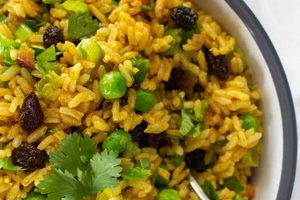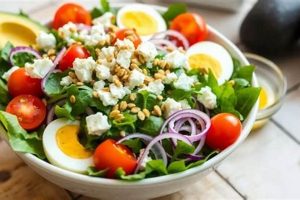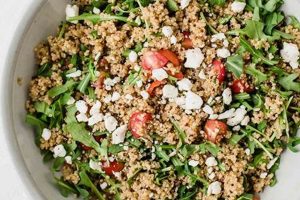A simple salad inspired by the flavors of the American Southwest typically features ingredients such as corn, black beans, avocado, tomatoes, and a cilantro-lime dressing. Variations may include grilled chicken or shrimp, different types of beans, and the addition of cheese or crunchy tortilla strips. An example might involve combining romaine lettuce, grilled corn, black beans, diced avocado, chopped tomatoes, and crumbled cotija cheese, tossed with a dressing of lime juice, olive oil, and chopped cilantro.
Quick and flavorful salads offer convenient and healthy meal options. The combination of fresh produce, lean proteins, and vibrant spices contributes to a balanced and nutritious diet. The Southwest’s culinary heritage, influenced by Indigenous, Spanish, and Mexican traditions, emphasizes the use of readily available ingredients and bold flavors. This focus on simplicity and taste has contributed to the popularity of these types of salads in contemporary cuisine.
This exploration of Southwestern-inspired salads will cover variations on the core recipe, including ingredient substitutions, dressing options, and tips for preparation and presentation. It will also provide nutritional information and address common questions about adapting the recipe for dietary restrictions.
Tips for a Flavorful and Easy Southwest Salad
Optimizing flavor and streamlining preparation are key to a successful Southwest-inspired salad. The following tips offer guidance on achieving both.
Tip 1: Fresh Ingredients are Paramount: The vibrancy of a Southwest salad relies heavily on the freshness of its components. Select ripe avocados, juicy tomatoes, and crisp lettuce for optimal flavor and texture.
Tip 2: Embrace Variety in Beans: While black beans are common, consider incorporating other varieties like pinto or kidney beans for a nuanced flavor profile and added nutritional value.
Tip 3: Customize the Heat: Adjust the level of spice by incorporating jalapeos, chipotle peppers, or a pinch of cayenne pepper into the dressing or directly into the salad.
Tip 4: Grill for Enhanced Flavor: Grilling corn, bell peppers, or onions before adding them to the salad imparts a smoky char and enhances their sweetness.
Tip 5: Balance with Acidity: A touch of acidity brightens the flavors. Lime juice is traditional, but lemon juice or a splash of red wine vinegar can also work well.
Tip 6: Enhance with Texture: Toasted pepitas (pumpkin seeds), crushed tortilla chips, or crispy onions add a satisfying crunch.
Tip 7: Prepare Components in Advance: Chop vegetables and prepare the dressing ahead of time to expedite assembly when ready to serve.
By following these tips, one can create a flavorful and convenient salad that embodies the essence of Southwestern cuisine. These simple techniques maximize the impact of fresh, wholesome ingredients.
These practical suggestions provide a foundation for crafting a delicious and personalized Southwest-inspired salad. The subsequent section will offer concluding thoughts on the adaptability and overall appeal of this versatile dish.
1. Fresh Ingredients
The emphasis on fresh ingredients is integral to an easy Southwest salad recipe. Flavorful Southwest cuisine relies on the vibrancy of individual components. Fresh produce provides optimal taste and texture, crucial for a simple, yet satisfying dish. The crispness of lettuce, the juiciness of tomatoes, and the creaminess of ripe avocado contribute significantly to the overall sensory experience. Using canned or otherwise processed ingredients can result in a muted, less vibrant flavor profile. For example, fresh cilantro provides a bright, citrusy aroma and taste that dried cilantro flakes cannot replicate. Similarly, freshly squeezed lime juice offers a more nuanced acidity compared to bottled lime juice.
This prioritization of fresh ingredients also contributes to the “easy” aspect of the recipe. Minimal processing is required when working with fresh produce. Washing, chopping, and combining fresh ingredients involves less effort than more complex culinary techniques. This focus on simplicity allows for quick preparation, aligning with the goal of an easy and convenient meal. Furthermore, the natural flavors of fresh ingredients often require minimal seasoning, further streamlining the cooking process. A simple dressing of olive oil, lime juice, and spices is often sufficient to complement the flavors of fresh produce, eliminating the need for complex sauces or marinades.
In conclusion, the use of fresh ingredients is paramount in achieving a truly delicious and easy Southwest salad. The quality of ingredients directly impacts both the flavor complexity and the ease of preparation. Selecting fresh produce maximizes the vibrancy of the salad while minimizing the need for extensive processing or complex flavor enhancements. This emphasis on freshness aligns with the broader culinary principles of Southwest cuisine, which celebrates the natural flavors of readily available ingredients. This understanding enables the creation of a simple, healthy, and satisfying meal with minimal effort.
2. Simple Preparation
Simple preparation is a defining characteristic of an easy Southwest salad recipe. The ease of assembly contributes significantly to the recipe’s appeal, making it a practical choice for quick meals. Minimal culinary skills are required; the process typically involves chopping vegetables, opening cans of beans and corn (if not using fresh), and whisking together a straightforward dressing. This simplicity reduces preparation time, making the recipe suitable for weeknight dinners or impromptu lunches. For example, a basic Southwest salad can be assembled in under 15 minutes, even with variations like grilling chicken or shrimp. This ease of preparation distinguishes it from more labor-intensive salads requiring multiple steps or specialized techniques.
The straightforward nature of the recipe extends beyond basic assembly. The inherent flexibility of Southwest cuisine allows for substitutions based on ingredient availability and personal preference. No precise measurements are typically required for the dressing or the components of the salad itself, encouraging improvisation and customization. This adaptability contributes to the simplicity, removing the pressure of strict adherence to a recipe. Furthermore, many components can be prepared in advance. Chopping vegetables and making the dressing ahead of time saves valuable minutes when assembling the salad. This make-ahead approach makes the recipe even more convenient for those with busy schedules.
The connection between simple preparation and an easy Southwest salad recipe is fundamental to its popularity. The accessibility of the recipe, combined with its fresh, flavorful profile, makes it an attractive option for individuals seeking healthy and convenient meals. This ease of preparation removes a significant barrier to healthy eating, promoting the inclusion of fresh produce in regular diets. The adaptability and minimal time commitment associated with Southwest salads increase the likelihood of regular consumption, contributing to a healthier lifestyle. Understanding this connection underscores the value of simple, flavorful recipes in promoting healthy dietary habits.
3. Vibrant Flavors
Vibrant flavors are central to the appeal of an easy Southwest salad recipe. The interplay of sweet, spicy, tangy, and savory notes creates a complex and satisfying taste experience that distinguishes this salad from other, simpler variations. This complexity is achieved through a combination of fresh ingredients and characteristic Southwest spices. The inherent sweetness of corn and bell peppers complements the earthy notes of black beans and the creamy richness of avocado. A cilantro-lime dressing provides a bright, citrusy counterpoint, while the addition of spices like cumin, chili powder, and cayenne pepper introduces varying levels of heat. The careful balance of these flavors is key to the recipe’s success.
The vibrancy of the flavors also contributes to the “easy” aspect of the recipe. Bold flavors often require less reliance on salt or other seasonings, aligning with healthy eating principles. For example, the inherent spiciness of jalapeos or chipotle peppers can eliminate the need for excessive sodium. Furthermore, the distinct flavors of each ingredient contribute to a satisfying experience without requiring complex preparation techniques or lengthy cooking times. A simple grilling of corn or onions can intensify their natural sweetness, further enhancing the overall flavor profile without adding complexity to the preparation process. The vibrant flavors inherent in the core ingredients minimize the need for intricate sauces or marinades, simplifying the recipe and reducing preparation time.
Achieving a balance of vibrant flavors is essential for a successful easy Southwest salad. The interplay of contrasting yet complementary tastes creates a dynamic culinary experience. This flavor complexity contributes significantly to the recipe’s popularity, offering a satisfying and healthy meal option without demanding extensive culinary expertise or time commitment. This understanding facilitates the creation of a simple yet flavorful salad, promoting the enjoyment of fresh, wholesome ingredients and the exploration of Southwest cuisine’s vibrant culinary heritage.
4. Customizable Spices
The ability to customize spices is integral to the concept of an “easy Southwest salad recipe.” Southwest cuisine is known for its bold flavors, often incorporating chiles, cumin, coriander, and smoked paprika. However, individual preferences for heat and spice intensity vary considerably. Customizable spices allow each individual to tailor the salad to their palate, ensuring a pleasant culinary experience regardless of spice tolerance. This adaptability is crucial for making the recipe accessible to a wider audience, from those who prefer mild flavors to those who enjoy a fiery kick. For instance, a mild Southwest salad might utilize cumin and smoked paprika for flavor depth without significant heat, while a spicier version could incorporate jalapeos, chipotle powder, or cayenne pepper. This customization extends beyond the type of spice to the quantity used. A recipe might suggest a range for spice amounts, allowing individuals to fine-tune the heat level to their liking. This flexibility simplifies the recipe, eliminating the need for separate versions catering to different spice preferences.
This customizability also contributes to the “easy” aspect of the recipe. Pre-mixed spice blends marketed as “Southwest seasoning” are readily available, offering a convenient shortcut. However, these blends may not cater to individual tastes. Utilizing individual spices empowers control over the final flavor profile. One can start with small amounts of each spice and gradually increase until the desired intensity is reached. Furthermore, customization enables exploration of flavor nuances. Smoked paprika offers a distinct smoky depth, while ancho chili powder contributes a milder, earthier heat compared to cayenne. Experimenting with different combinations of spices allows for the creation of a personalized Southwest salad tailored to specific taste preferences. This personalized approach enhances the enjoyment of the dish, encouraging exploration of the Southwest flavor palette.
Spice customization contributes significantly to the overall success of an easy Southwest salad recipe. It allows individuals to control the heat level and explore flavor complexities, personalizing the dish to their preferences. This adaptability makes the recipe more accessible and enjoyable for a wider range of palates, reinforcing its “easy” nature. Understanding this connection between customizable spices and an easy Southwest salad highlights the importance of flexibility in recipe design, promoting a positive and personalized culinary experience. This personalization, in turn, encourages culinary exploration and the adoption of healthy eating habits.
5. Healthy Option
The designation of “southwest salad recipe easy” as a healthy option stems from the inherent nutritional value of its core ingredients and the adaptability of the recipe to various dietary needs. This nutritional profile aligns with contemporary dietary guidelines emphasizing whole foods, lean proteins, and healthy fats. The recipe’s flexibility further reinforces its health benefits, allowing for modifications that accommodate specific dietary restrictions or preferences.
- Fresh Produce Foundation:
The foundation of a Southwest salad rests upon fresh produce. Leafy greens like romaine or spinach provide essential vitamins and minerals with minimal calories. Tomatoes, corn, and bell peppers contribute antioxidants and fiber. These nutrient-dense ingredients offer substantial health benefits, promoting digestive health and reducing the risk of chronic diseases. The emphasis on fresh, unprocessed produce distinguishes the Southwest salad from less healthy options relying on processed or calorie-dense ingredients.
- Lean Protein Incorporation:
Southwest salads often incorporate lean protein sources like grilled chicken, fish, or beans. These proteins are essential for muscle building and satiety, promoting a feeling of fullness and reducing overeating. Beans, in particular, offer both protein and fiber, further enhancing the nutritional value of the salad. This inclusion of protein elevates the Southwest salad from a side dish to a complete and balanced meal.
- Healthy Fats from Avocado:
Avocado, a frequent component of Southwest salads, provides healthy monounsaturated fats. These fats contribute to heart health, improve cholesterol levels, and aid in the absorption of fat-soluble vitamins. The inclusion of avocado adds a creamy texture and rich flavor to the salad, enhancing its palatability while simultaneously boosting its nutritional value. This healthy fat source distinguishes the Southwest salad from salads relying on less healthy dressings or toppings.
- Adaptability for Dietary Needs:
The adaptable nature of the Southwest salad recipe makes it suitable for various dietary restrictions. Gluten-free versions are readily achieved by omitting croutons or using corn tortillas for added crunch. Vegetarian and vegan variations are easily created by substituting beans for meat or omitting cheese. This adaptability allows individuals with dietary restrictions to enjoy a flavorful and nutritious salad without compromising their health needs. This flexibility distinguishes the Southwest salad from less adaptable recipes that may be difficult to modify for specific dietary requirements.
The convergence of these factors solidifies the Southwest salad’s status as a healthy option. The focus on fresh produce, lean protein, healthy fats, and adaptability distinguishes this salad from less nutritious alternatives. This nutritional profile, combined with the ease of preparation, makes the Southwest salad a practical and appealing choice for individuals seeking healthy and convenient meal options. The ability to customize ingredients based on individual dietary needs and preferences further reinforces the Southwest salad’s position as a versatile and health-conscious meal choice.
6. Versatile Proteins
The versatility of protein options contributes significantly to the “easy” aspect of a Southwest salad recipe. This adaptability accommodates diverse dietary preferences and needs, expanding the recipe’s appeal beyond a single demographic. Traditional meat-based proteins like grilled chicken or steak readily complement the Southwest flavor profile. However, the recipe easily adapts to vegetarian and vegan diets through the incorporation of beans, lentils, tofu, or tempeh. This inclusivity broadens the recipe’s reach, making it a practical choice for individuals following various dietary patterns. For example, black beans, a staple in many Southwest dishes, provide a plant-based protein source rich in fiber, aligning with both vegetarian and health-conscious diets. Similarly, grilled tofu, marinated in Southwest spices, offers a flavorful vegan alternative. This adaptability simplifies meal planning, eliminating the need for separate recipes catering to different dietary requirements.
Furthermore, the versatility of proteins enhances the nutritional value of the Southwest salad. Different protein sources offer varying nutritional profiles. Lean meats provide essential amino acids, while plant-based options contribute fiber and complex carbohydrates. This diversity allows individuals to tailor the salad to their specific nutritional needs. For instance, incorporating quinoa adds a complete protein source rich in iron and magnesium, while adding grilled salmon provides omega-3 fatty acids. This nutritional flexibility elevates the Southwest salad from a simple dish to a customizable meal that can be adjusted to meet specific health goals. The ease with which these proteins can be incorporated further emphasizes the “easy” aspect of the recipe. Grilled chicken or fish can be added directly to the salad, while pre-cooked beans or lentils require minimal preparation. This convenience encourages the inclusion of protein in the salad, further enhancing its nutritional value and promoting a balanced diet.
The connection between versatile proteins and an “easy Southwest salad recipe” lies in the recipe’s adaptability and nutritional flexibility. The ease with which various protein sources can be incorporated, combined with the diverse nutritional benefits they offer, expands the recipe’s appeal and practicality. This versatility simplifies meal preparation, accommodates diverse dietary needs, and promotes balanced nutrition. Understanding this connection underscores the importance of adaptability in recipe design and its impact on promoting healthy and inclusive dietary choices. This adaptable framework allows the Southwest salad to function as a customizable template, accommodating individual preferences and nutritional goals within a simple and flavorful culinary experience.
7. Quick Meal Solution
The designation of “southwest salad recipe easy” as a quick meal solution stems from the minimal preparation time and inherent adaptability of the recipe. This speed and flexibility are crucial for individuals and families seeking nutritious meals without extensive cooking or complex preparation steps. The “quick meal solution” aspect directly connects to the “easy” component of the recipe, emphasizing convenience and efficiency in meal preparation. The following facets explore this connection in greater detail.
- Minimal Preparation Time:
Southwest salads require minimal active cooking time. Chopping vegetables, opening cans (if using canned ingredients), and whisking together a simple dressing constitute the majority of the preparation process. Even with additions like grilled chicken or shrimp, the total preparation time remains relatively short, typically under 30 minutes. This minimal time commitment makes the recipe ideal for weeknight meals or situations where time is limited.
- Adaptable to Available Ingredients:
The flexible nature of Southwest cuisine allows for ingredient substitutions based on availability. If fresh corn is unavailable, frozen or canned corn functions as an adequate substitute. Similarly, various types of beans, lettuce, and proteins can be incorporated depending on what is readily available. This adaptability reduces the need for specific grocery shopping trips, making the recipe a practical choice for utilizing existing pantry staples.
- Make-Ahead Components:
Many components of a Southwest salad can be prepared in advance. Chopping vegetables and making the dressing a day or two ahead significantly reduces preparation time when assembling the final salad. This make-ahead approach transforms the Southwest salad into a truly quick meal solution, requiring minimal effort immediately before serving.
- Satisfying and Complete Meal:
Southwest salads provide a balanced combination of nutrients, including protein, healthy fats, and fiber. This nutritional profile contributes to satiety, preventing feelings of hunger shortly after eating. This characteristic distinguishes the Southwest salad from less satisfying quick meal options that may not provide adequate nutrition or promote fullness. This completeness further contributes to the “quick meal solution” aspect, as it eliminates the need for supplemental dishes or snacks.
The confluence of these facets solidifies the Southwest salad’s position as a quick and easy meal solution. The minimal preparation time, adaptability to available ingredients, make-ahead components, and satisfying nutritional profile combine to offer a convenient and healthy meal option. This convenience directly correlates with the “easy” aspect of the recipe, making it an attractive choice for individuals and families seeking nutritious meals without sacrificing time or requiring complex culinary skills. The quick and easy nature of the Southwest salad facilitates healthy eating habits by removing common barriers to meal preparation, such as time constraints and limited ingredient availability. This understanding underscores the recipe’s value as a practical and healthful culinary solution in today’s fast-paced world.
Frequently Asked Questions
This section addresses common inquiries regarding easy Southwest salad recipes, providing clear and concise information to facilitate successful preparation and enjoyment.
Question 1: Can canned ingredients be used in a Southwest salad?
While fresh ingredients are preferred for optimal flavor and texture, canned beans, corn, and diced tomatoes can be used as convenient substitutes. Rinsing canned ingredients thoroughly before use helps reduce sodium content.
Question 2: What are the best lettuce options for a Southwest salad?
Romaine lettuce is a popular choice due to its crisp texture and ability to hold up well to heavier toppings. Other suitable options include butter lettuce, iceberg lettuce, or a spring mix.
Question 3: How can spice levels be adjusted in a Southwest salad?
Spice levels can be adjusted by varying the amount of chili powder, cayenne pepper, or jalapeos used in the dressing or added directly to the salad. Omitting these ingredients entirely creates a mild flavor profile.
Question 4: What are some suitable protein additions for a Southwest salad?
Grilled chicken, shrimp, or fish are popular protein choices. For vegetarian options, black beans, pinto beans, or lentils are excellent additions. Tofu or tempeh, when seasoned and grilled, provide suitable vegan protein sources.
Question 5: How long can a Southwest salad be stored in the refrigerator?
A Southwest salad without dressing can typically be stored in an airtight container in the refrigerator for up to three days. Adding the dressing immediately before serving helps maintain the crispness of the lettuce and other vegetables.
Question 6: Can a Southwest salad be made ahead of time for a large gathering?
Preparing components such as chopped vegetables, cooked proteins, and the dressing in advance facilitates assembly closer to serving time. Store these components separately and combine them just before serving to prevent the salad from becoming soggy.
Understanding these common inquiries provides a solid foundation for creating and enjoying a delicious and easy Southwest salad. Adaptability is key, and these responses highlight the versatility of the recipe.
The following section will offer concluding remarks regarding the overall appeal and adaptability of easy Southwest salad recipes.
Conclusion
Exploration of the “southwest salad recipe easy” concept reveals a culinary approach prioritizing simplicity, flavor, and adaptability. Fresh ingredients, characteristic Southwest spices, and versatile protein options combine to create a nutritious and customizable meal. The ease of preparation, often involving minimal cooking and readily available ingredients, positions this salad as a practical solution for time-constrained individuals seeking healthy dietary choices. The adaptability of the recipe accommodates diverse dietary needs, ranging from meat-inclusive to vegetarian and vegan variations. This flexibility extends to spice levels, allowing customization based on individual preferences. The combination of fresh produce, lean proteins, and customizable flavors distinguishes the Southwest salad as a versatile and health-conscious meal option.
The enduring appeal of the easy Southwest salad recipe lies in its ability to balance convenience with nutritional value and flavor complexity. This balance reflects a broader culinary trend emphasizing healthful, adaptable recipes that meet the demands of modern lifestyles. Continued exploration of Southwest cuisine promises further innovation within this culinary framework, potentially yielding new variations on the classic Southwest salad. This potential for culinary evolution ensures the enduring relevance of the “southwest salad recipe easy” concept within the broader context of healthy and convenient cuisine.






